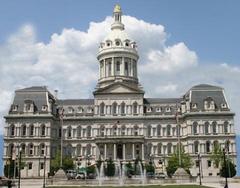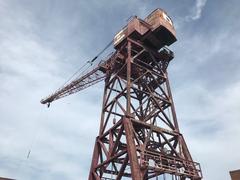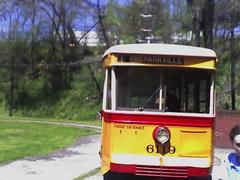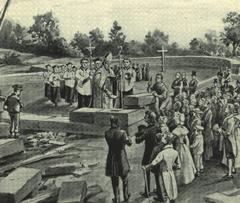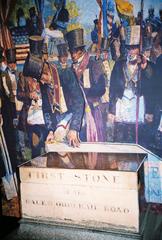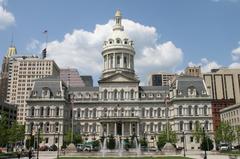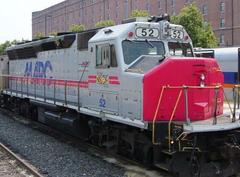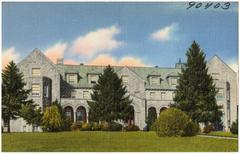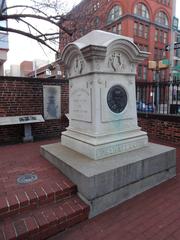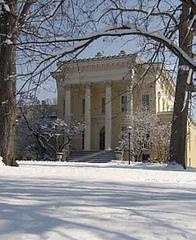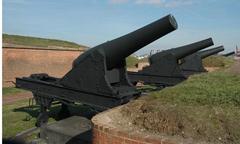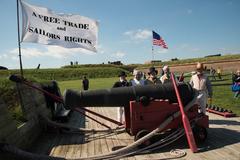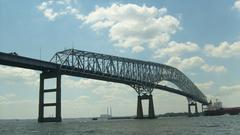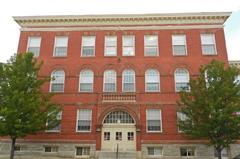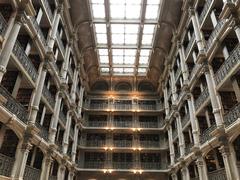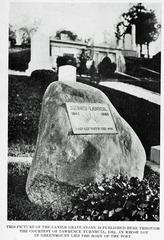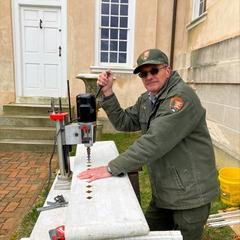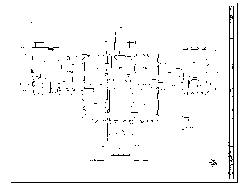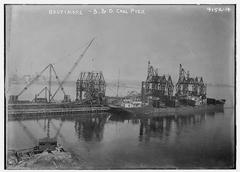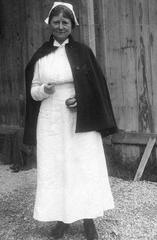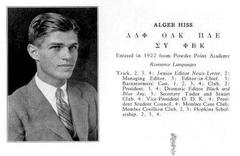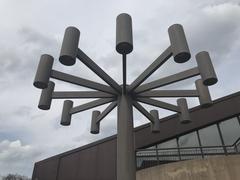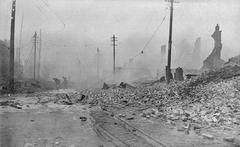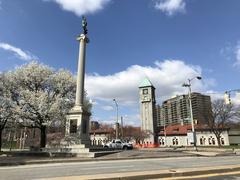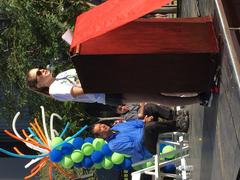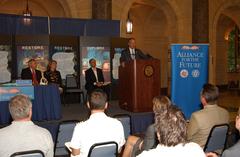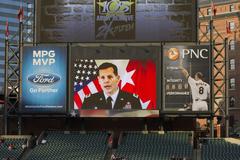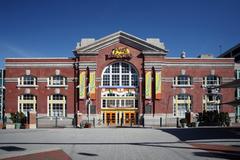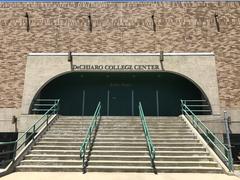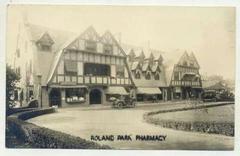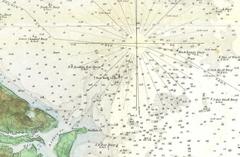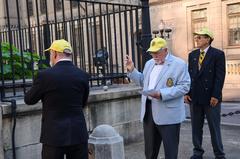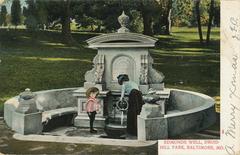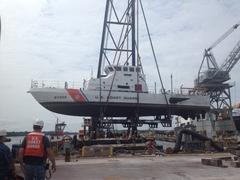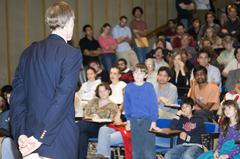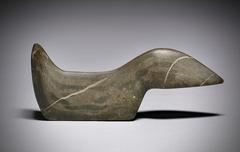
Bank of America Building Baltimore: Visiting Hours, Tickets, and Historical Sites Guide
Date: 04/07/2025
Introduction
The Bank of America Building in Baltimore, originally completed in 1929 as the Baltimore Trust Company Building, is a towering emblem of the city’s architectural ambition and economic history. As Baltimore’s tallest building for more than four decades, its 34-story Art Deco silhouette and ornate limestone façade have captivated visitors and locals alike. Situated in the heart of the Central Business District, near the vibrant Inner Harbor, this landmark offers a portal into Baltimore’s urban evolution, resilience through the Great Depression, and ongoing preservation efforts. This comprehensive guide covers everything you need to know about visiting the Bank of America Building, including its history, architectural highlights, visitor information, accessibility, nearby attractions, and tips for making the most of your experience (NPS.gov; Wikipedia; Baltimore Magazine).
Table of Contents
- Introduction
- Origins and Early Development
- Architectural Significance and Design
- Impact of the Great Depression
- Role in Baltimore’s Urban Evolution
- Preservation and Contemporary Significance
- Visiting the Bank of America Building
- Notable Events and Cultural Context
- Legacy and Influence
- FAQs
- Conclusion
- Visuals and Media
- Related Articles
- References
Origins and Early Development
The Bank of America Building, originally the Baltimore Trust Company Building, rose from the optimism of the late 1920s. Construction began in 1928 and concluded in 1929, with the intent to project the Baltimore Trust Company’s economic strength and to symbolize the city’s emergence as a financial hub. The site at 10 Light Street replaced the old International Trust Company Building, reflecting a broader trend of urban renewal following the Great Baltimore Fire of 1904 (NPS.gov).
Architectural Significance and Design
Art Deco Masterpiece and Setback Skyscraper
The Bank of America Building is Baltimore’s only true “setback” skyscraper, a hallmark of Art Deco commercial architecture. Rising to 509 feet (155 meters), it was the tallest office structure in the United States south of New York City upon completion (Wikipedia). The setback design was not only stylish but also a response to 1920s zoning laws, allowing more light at street level and creating a tiered, dynamic silhouette (SAH Archipedia).
Materials and Decorative Elements
A steel frame clad in Indiana limestone and local brick provides both strength and elegance. The façade is adorned with geometric Art Deco motifs, including sunbursts and stylized Maryland wildlife—eagles, owls, and crabs—crafted by sculptor Louis Fentner. The building is capped with a distinctive copper and gold roof, which remains a beacon on the city’s skyline (Wikipedia; SAH Archipedia).
Interior Grandeur
The two-story main banking hall features mosaic floors by acclaimed artist Hildreth Meiere, and historic murals by Griffith Baily Coale and McGill Mackall. These artworks commemorate pivotal moments in Baltimore and Maryland history, such as the Great Baltimore Fire and the composition of the National Anthem (Wikipedia).
Impact of the Great Depression
The building’s inauguration coincided with the market crash of 1929, which led to the Baltimore Trust Company’s bankruptcy within a year. The skyscraper stood largely vacant until the economic recovery of World War II, when it was converted into rental office space, marking its transition from a symbol of prosperity to one of endurance (NPS.gov).
Role in Baltimore’s Urban Evolution
Strategically located in the Central Business District, the building embodies Baltimore’s shift toward modernity after the Great Fire. Its survival through economic downturns and changing urban trends is a testament to the city’s resilience. The structure’s continued presence as both a business hub and architectural landmark reflects Baltimore’s ongoing efforts at revitalization (Baltimore Magazine).
Preservation and Contemporary Significance
Designated as a Baltimore City Landmark, the Bank of America Building is protected under local preservation ordinances. Its Art Deco features and mosaics are celebrated in architectural studies, and the building remains a popular subject for urban photographers and history enthusiasts (CHAP Landmark List).
Visiting the Bank of America Building
Visiting Hours
- Lobby and public areas: Monday through Friday, 8:00 a.m. – 6:00 p.m.
- Exterior viewing: Accessible at any time.
Please check with building management or local tourism offices for updated hours and holiday closures.
Entry and Tickets
- Admission: Free
- Public tours: Not regularly scheduled; check for special events or Doors Open Baltimore programs.
Accessibility
- Wheelchair-accessible entrances and elevators are available.
- For accessibility needs or assistance, contact building management before visiting.
Guided Tours and Special Events
- Occasional tours are offered through local historical societies or during citywide events.
- Self-guided tours are possible; consider using apps like GPSmyCity for architectural insights (GPSmyCity).
Nearby Attractions and Travel Tips
- Inner Harbor: National Aquarium, Maryland Science Center, and waterfront promenades.
- Cultural sites: Walters Art Museum, American Visionary Art Museum, and Mount Vernon.
- Public transit: Charles Center Metro, Light RailLink, Charm City Circulator, and MTA bus stops nearby (Baltimore.org).
- Parking: Garages available, but public transit is recommended during busy periods.
Photographic Spots
- Best angles: Intersection of Light Street and Redwood Street for upward views; Inner Harbor promenade for skyline shots.
- Nighttime: The illuminated crown is especially striking after dusk.
Notable Events and Cultural Context
The Bank of America Building’s story mirrors Baltimore’s economic ebbs and flows. It is recognized as a canvas for public art, with nearby murals celebrating the city’s maritime and multicultural history (Buenos Aires Street Art). The building also features in city festivals, such as Artscape and Fourth of July fireworks, providing a dramatic backdrop to urban celebrations (Baltimore.org).
Legacy and Influence
The Bank of America Building’s bold Art Deco design set a precedent for high-rise construction in Baltimore, influencing subsequent architecture and symbolizing the city’s aspirations. Its evolution from financial headquarters to a preserved landmark underscores the dynamic interplay between architecture, economics, and urban identity (NPS.gov).
Frequently Asked Questions (FAQ)
What are the visiting hours?
Monday–Friday, 8:00 a.m. to 6:00 p.m. Public access is limited to the lobby and exterior.
Is there an admission fee?
No, visiting the exterior and lobby is free.
Are guided tours available?
Special tours may occur during events; otherwise, no regular tours are offered.
Is the building accessible?
Yes, ADA-compliant entrances and elevators are provided.
Where can I park?
Nearby garages are available; public transport is recommended during events.
What are the best times for photography?
Dusk or after dark for the illuminated crown; daytime for Art Deco details.
Conclusion
The Bank of America Building is more than an office tower—it is a living monument to Baltimore’s architectural innovation, economic history, and cultural vitality. Its Art Deco grandeur, setback design, and historical significance make it a must-see for architecture lovers and history enthusiasts. While public access is limited, the building’s continued presence and preservation ensure that it remains a cornerstone of Baltimore’s dynamic cityscape. Enhance your experience by exploring nearby attractions, joining special tours when available, and using digital resources like the Audiala app for deeper insights.
Visuals and Media
Alt text: Bank of America Building Baltimore showcasing its distinctive Art Deco setbacks and geometric ornamentation.
Related Articles
Summary and Visitor Recommendations
In summary, the Bank of America Building is a testament to Baltimore’s architectural excellence and cultural resilience. As a preserved Art Deco landmark, it invites visitors to appreciate its design, learn its history, and explore the vibrant neighborhoods that surround it. For the full Baltimore experience, combine your visit with tours of the Inner Harbor, local museums, and historic districts. Use resources like the Audiala app and local visitor centers to maximize your trip (NPS.gov; Baltimore Magazine; Visit Maryland).
References
- Exploring the Bank of America Building Baltimore: Visiting Hours, History, and More, 2025, National Park Service
- Exploring the Bank of America Building Baltimore: Visiting Hours, Tickets, and Architectural Highlights, 2025, Wikipedia & SAH Archipedia
- Visiting the Bank of America Building Baltimore: History, Tickets, Hours & Nearby Attractions, 2025, Visit Maryland & Baltimore.org
- Bank of America Building Baltimore: Visiting Hours, History & Tourist Guide, 2025, Baltimore City Landmark List & PlanetWare





